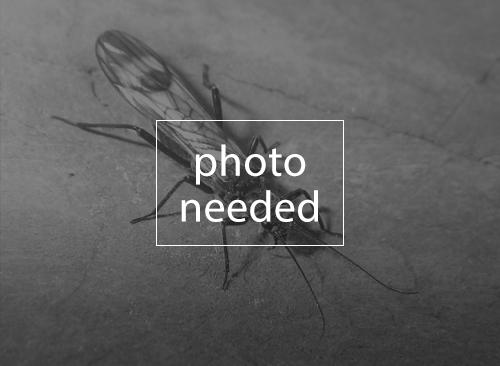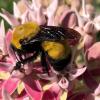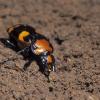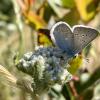
Hylaeus longiceps is a coastal bee endemic to the islands of Oahu, Molokai, Lanai, and Maui in Hawaii. It is distinguished by its long head and large facial marks. It can be found relatively abundantly where it exists, but habitat destruction has caused its range to contract significantly. Hylaeus longiceps is restricted to small, widely scattered sites, and populations are vulnerable to extinction.
Males
Face entirely yellow below the antennae, with broad lateral marks extending dorsally. Head long, supraclypeal area longer than wide; scape narrow, twice as long as wide. Hairs of abdominal apex brown, appressed.
Females
Entirely black, lacking coloration. Frons with distinct, well-defined punctation. Hylaeus longiceps is a member of the flavipes species group. Males can be easily distinguished by the long head and extensive facial marks; females can be told apart only by details of sculpture. Separation of this species and H. finitimus (if indeed they are distinct species) is uncertain due to loss of the only male specimen of the latter and ambiguous descriptions.
Taxonomic Status
Hylaeus longiceps was described as Nesoprosopis longiceps by Perkins (1899). Nesoprosopis was reduced to a subgenus of Hylaeus by Meade-Waldo (1923). The most recent taxonomic treatment was Daly and Magnacca (2003).
Hylaeus longiceps inhabits coastal strand and dry shrubland. It can be found on a wide variety of plants. Nesting habits are unknown, but it probably nests in the ground like related species.
Found on Oahu, Molokai, Lanai, and Maui. Although it is the most abundant coastal species on the middle islands, it is still restricted to small patches of habitat. The largest area is probably on Molokai, where an area of sand dunes stretching from Moomomi to Kalaupapa may support a large population. Elsewhere it is found at Kaena Point on Oahu; Polihua and Shipwreck Beach on Lanai; and Waikapu and Waiehu on Maui. Additional sites may exist, but it is likely that they too will be small areas.
Xerces Red List Status: Critically Imperiled
Other Rankings:
Canada – Species at Risk Act: N/A
Canada – provincial status: N/A
Mexico: N/A
USA – Endangered Species Act: Species of Concern
USA – state status : HI: Species of Concern
NatureServe: GNR
IUCN Red List: N/A
This species is restricted to small, scattered populations. Originally, U.S. Federal listings of rare and endangered species classed H. longiceps as a “Category 2” Candidate Species about which more information was needed before it could be considered for listing. This status was based on recognition that Hawaiian bees in general were becoming rarer and little was known about their conservation status. Data were never gathered to document whether or not this species should be proposed for listing. It is currently considered to be a “Species of Concern” or a “Special Status Species” by the U.S. Fish and Wildlife Service and the Hawaii Division of Forestry and Wildlife.
The biggest threat to H. longiceps is habitat loss. Although the species can be found in relative abundance in some areas, native coastal strand vegetation is now extremely rare and usually limited to small sites.
Populations of H. longiceps on Oahu and Molokai are protected under the auspices of the State of Hawaii and the Nature Conservancy. Those on Maui are potentially threatened by development; there is little such risk on Lanai but they may face habitat degradation due to erosion and other factors. All sites are suceptible to fire. Maintenance of remaining habitat is the highest conservation priority. Research is needed to search for additional populations, especially on Oahu and Maui.
Daly, H. V., and K. N. Magnacca. 2003. Insects of Hawaii, Vol. 17: Hawaiian Hylaeus (Nesoprosopis) Bees (Hymenoptera: Apoidea). University of Hawaii Press, Honolulu. 234 pp.
Meade-Waldo, G. 1923. Hymenoptera, fam. Apidae, subfam. Prosopidae, fasc. 181. Pp. 1-45 in P. Wytsman (ed.), Genera Insectorum. L. Desmet-Verteneuil, Brussels.
Perkins, R. C. L. 1899. Hymenoptera, Aculeata. Pp. 1-115 in D. Sharp (ed.), Fauna Hawaiiensis, Vol. 1. Cambridge University Press, Cambridge, United Kingdom.
Citation
Magnacca, K. N. 2005. Species Profile: Hylaeus longiceps. In Shepherd, M. D., D. M. Vaughan, and S. H. Black (Eds). Red List of Pollinator Insects of North America. CD-ROM Version 1 (May 2005). Portland, OR: The Xerces Society for Invertebrate Conservation.
Profile prepared by Karl Magnacca, USGS-BRD, Kilauea Field Station





